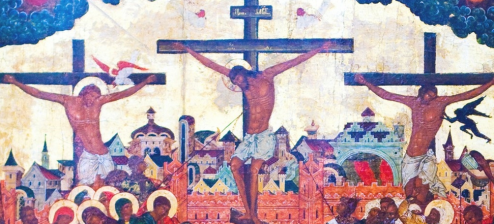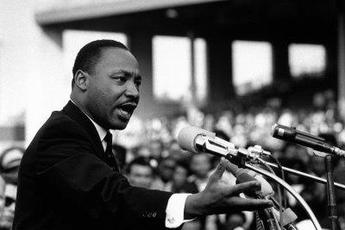I dare Mark Driscoll to call this young lady a “pansy”.
Mark Driscoll’s article, “Is God a Pacifist?“, has spurred a lot of online discussion and debate—and rightly so, because his article raises (and glosses-over) several complex and difficult topics.
In my own understanding of Jesus’ teachings, his life, and the practices of the early church, I lean heavily towards pacifism. However, I know that if my family were threatened with violence, my response could be anything but peaceful or lacking in violence. Beyond this inner and (thankfully) theoretical struggle of “what would I do?”, my initial thoughts after reading Driscoll’s post were these (though not in the order I felt them):
The Violence of God
1) Driscoll is right that in the scriptures God acts violently and brutally at times, both with surges of emotional anger and calculated judgement. This happens in the Hebrew scriptures beginning with the Flood , follows on occasion throughout various passages, and is predicted in New Testament texts as something that is to be expected in the future. Part of this prediction of judgement is recorded in the Gospels as even being given by Jesus himself, multiple times. To deny this is to deny the reality of what is in the Bible, and any approach that would knowingly do so must admit this, in my opinion. Too often we ignore images of God in the scripture that make us uncomfortable. Sometimes, if we were honest, the descriptions of God in the Bible embarrass us. This is true of Mark Driscoll, who doesn’t like a pacifist Jesus who says “turn the other cheek” and practices it, and it is true for those of us who would rather not deal with God’s messengers stomping on winepresses full of people (Revelation 14:19-20). So, we construct images of God that suit us better, that we can put on the altars of our agendas, and declare: “This is the God of the Bible!”, rather than honestly wrestling with these passages and with a God who just doesn’t seem to fit into our narrowly framed boxes.
Jesus is Our Example and Model
2) Driscoll is wrong in his attempt to associate our behavior or use of violence with God’s actions as a just judge, divine creator, and parent of us all. Rather, as human beings, the example for us is Jesus, who fills out and completes what faithful human existence looks like. God-in-humanity is our goal rather than God-as-deity. What Jesus gives us is a blueprint for how the imago Dei, the image of God, is to be fulfilled in human existence—and without a doubt Christ’s model is not one of violence, but one of suffering and serving for all, even enemies. There is nothing in the life or the teachings of Jesus that would advocate violence from one person to another. I don’t know how the following words could be interpreted (even if taken as hyperbole) as anything other than what we generally understand to be pacifism:
“But I say to you who hear, Love your enemies, do good to those who hate you,bless those who curse you, pray for those who abuse you.To one who strikes you on the cheek, offer the other also, and from one who takes away your cloak do not withhold your tunic either.Give to everyone who begs from you, and from one who takes away your goods do not demand them back.And as you wish that others would do to you, do so to them.
“If you love those who love you, what benefit is that to you? For even sinners love those who love them.And if you do good to those who do good to you, what benefit is that to you? For even sinners do the same. And if you lend to those from whom you expect to receive, what credit is that to you? Even sinners lend to sinners, to get back the same amount. But love your enemies, and do good, and lend, expecting nothing in return, and your reward will be great, and you will be sons of the Most High, for he is kind to the ungrateful and the evil.Be merciful, even as your Father is merciful.”
(Luke 6.27–36 ESV)
He goes on in that passage to say, “Why do you call me ‘Lord’ and not do what I say?”, and so he seems to want his followers to take these instructions seriously. The issue isn’t the clarity of Jesus’ statements on this. The issue is my own inability or unwillingness to live creatively and responsively in submission to it. Significantly, rather than grounding his teaching for human morals/ethics/faithfulness/identity in the violent aspects of God, Jesus grounds them in God’s mercy. Being “sons of God” in the previous passage is about being merciful like the Father— it is seemingly at the opposite end of the spectrum from Driscoll’s approach.
In addition, the early Church far and away followed this Christ-taught model of pacifism rather than violence, even at times suffering great harm and death at the hands of both government and local citizenry without violent response or defense.
Pacifism and “Pansies”
3) Driscoll is right: Jesus is not a pansy, but he’s wrong about what a “pansy” is. The notion that pacifism is something for “pansies” or “weaklings” belies a basic ignorance about the reality of what the practice of pacifism has meant and looked like historically. It certainly mis-portrays the Savior who willingly accepted and did not violently respond to the torture and death he received at the hands of (and for the sake of) his enemies. Anyone who would label those who have consistently chosen non-violence in the face of great violence, suffering, and death in such derogatory ways simply doesn’t know what they are talking about. How does one say such things about Gandhi, Bonhoeffer, Martin Luther King, Jr., or the millions of martyrs throughout history ? In the early Christian tradition, those who responded to violence with non-violence (even when facing the most horrible atrocities) were considered heroes.
Some of the Most Tenacious Fighters are Pacifists
4) Driscoll is wrong (or at least confused) in his basic notion that pacifists are not fighters. Pacifism is not passivism. Pacifists are often determined and tireless fighters, but their weapons are not of violence and their concern is not limited to a notion of victory that can only happen at a destructive cost to the personhood, dignity, or existence of those who would be their enemies. Pacifists like Gandhi and King understood that those who opposed them were also trapped and enslaved in systems blind to human-value, and that oppressors need to be set free just as well as the oppressed. “Winning” or “victory” in this scenario doesn’t demolish or destroy the enemy, but sets out to liberate enemies by turning them into friends and to non-violently resisting (and hopefully transforming) the systems that enslave. For Dr. King the method for this was clearly based upon Christ’s call to love one another and to love one’s enemies:
After contemplation, I conclude that this award which I receive on behalf of that movement is a profound recognition that nonviolence is the answer to the crucial political and moral question of our time – the need for man to overcome oppression and violence without resorting to violence and oppression. Civilization and violence are antithetical concepts. Negroes of the United States, following the people of India, have demonstrated that nonviolence is not sterile passivity, but a powerful moral force which makes for social transformation. Sooner or later all the people of the world will have to discover a way to live together in peace, and thereby transform this pending cosmic elegy into a creative psalm of brotherhood. If this is to be achieved, man must evolve for all human conflict a method which rejects revenge, aggression and retaliation. The foundation of such a method is love.
Dr. Martin Luther King Jr.
upon his acceptance of the Nobel Peace Prize
Oslo, 1964
As an example of this mentality, Driscoll’s post likewise brought to mind Jon Stewart’s recent interview on the Daily Show with the young Pakastani woman, Malala Yousafzai, who was shot in the face after standing up to the Taliban for the rights of girls and women to be educated (something she continues to do). In the interview, she stated regarding Taliban threats:
“…I started thinking about that, and I used to think that the Talib would come, and he would just kill me. But then I said, if he comes, ‘What would you do, Malala?’ Then I would reply to myself, ‘Malala, just take a shoe and hit him.’ [she smiles and the audience laughs]. But then I said, ‘If you hit a Talib with your shoe, then there would be no difference between you and the Talib. You must not treat others that much with cruelty, and that much harshly. You must fight others, but through peace and through dialogue and through education.’ Then I said I’ll tell him how important education is, and that I even want education for for your children, as well. And then I’ll tell him, ‘That’s what I want to tell you. Now do what you want.'”
As I said earlier: I dare Driscoll to call this young lady a “pansy”. She’s a pacifist, she’s a fighter, and she has the scars to prove it.
[EDIT: In the original version of this post, I erroneously stated that Malala was from Afghanistan. She is from Pakistan. I apologize for the slip of thinking and writing. I have corrected it in the title and in the article.—Jimmy]
[divider_1px]

